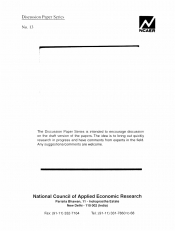Endogeneity of the Solow Residual: Some Evidence from Indian Data
June 2000
There are at least two reasons why the debate regarding the impact of openness through liberalization on oil productivity growth is unresolved. First, there is the adequate theory of TFP growth and second, the empirical measurement of TFP is fraught with difficulties. An important methodological issue that has attracted limited attention in India is regarding the assumptions that are necessary for implementing the traditional growth accounting approach. The assumptions of constant returns to scale, perfect competition and full capacity utilization must hold if unbiased estimates are to be obtained. Ideally the growth accounting technique should yield WI estimate of TFPG that is exogenous to the rate of growth of output. Any departure from these assumptions and/or error in the measurement of inputs or outputs leads to a pro-cyclical bias in the measurement of the Solow residual. The presence of such a pro-cyclical relationship between productivity and output often leads observers to erroneously conclude that there is a causal relationship between the two variables. In this paper, we present four examples from Indian data that help to illustrate the issues involved, concluding that, if the existence of market power or non-constant returns to scale is not accounted for, the Solow residual has a pro-cyclical bias. Second, both the single deflation and double deflation methods yield estimates of the total factor productivity residual that are pro-cyclical. Third, adjustment of the capital stock for capacity utilisation rates reduces the extent of the pro-cyclical bias but does not eliminate it. And finally, correcting for market power reduces the extent of the bias.
National Growth and Macroeconomic Centre







